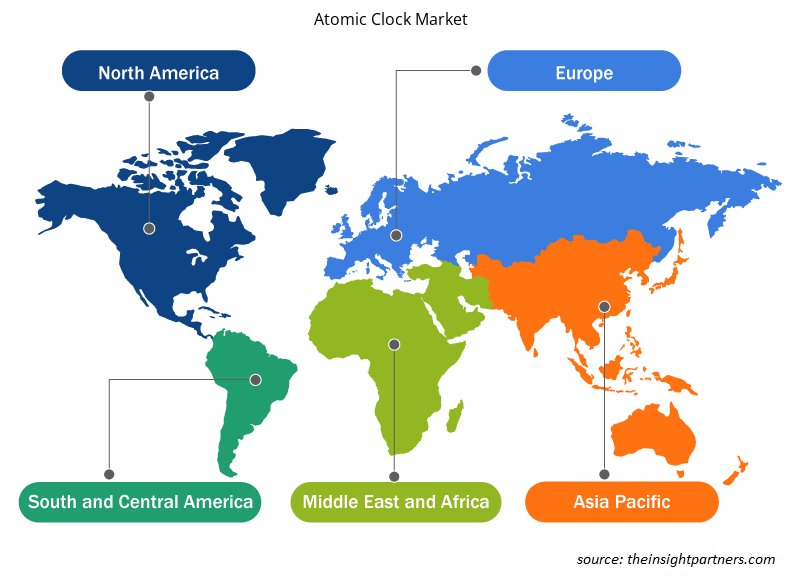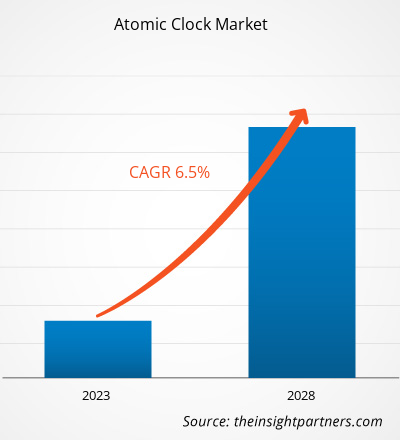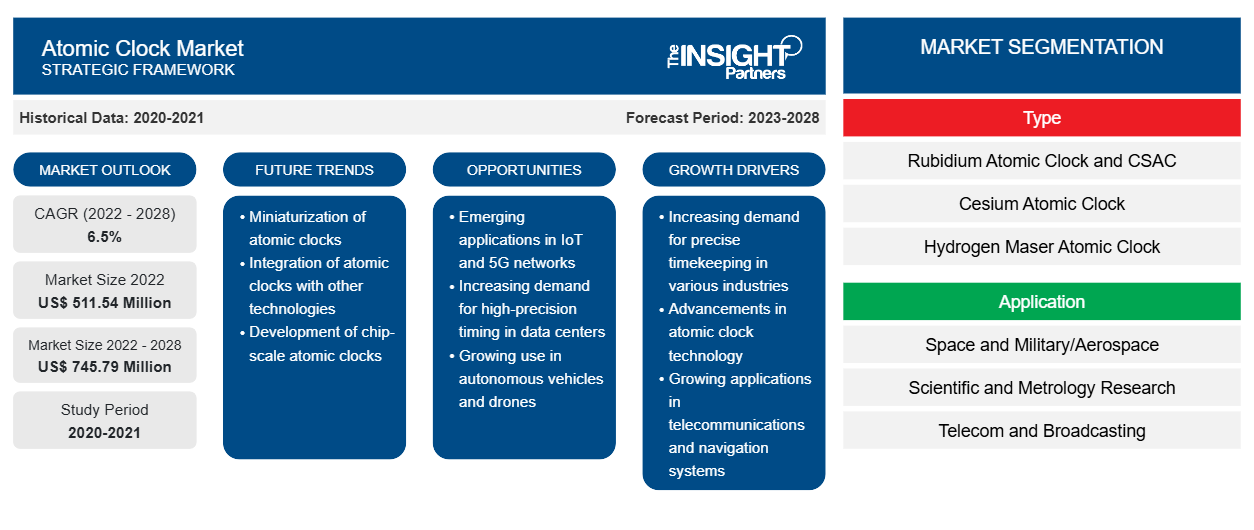Le marché des horloges atomiques devrait atteindre 745,79 millions de dollars américains d'ici 2028 ; il devrait croître à un TCAC de 6,5 % de 2022 à 2028.
Une horloge atomique est une horloge de précision, qui aide à la navigation GPS, à la synchronisation Internet et à l'identification précise de la position des planètes. La température des atomes de l'échantillon et la fréquence et la largeur de ligne intrinsèque de la transition électronique ou hyperfine sont deux facteurs dépendant de la précision d'une horloge atomique. Les hautes fréquences et les lignes étroites augmentent la précision. Les horloges au césium sont les horloges atomiques les plus précises disponibles sur le marché, et les États-Unis, la Suisse, la Russie et la Chine font partie des pays qui produisent des horloges au césium par lots. En conséquence, l'horloge atomique est une horloge précise avec un oscillateur électrique contrôlé par les fréquences de vibration naturelles du système atomique, telles que les faisceaux de césium, d'ammoniac ou de rubidium. Comme leur source d'oscillation dépend des caractéristiques atomiques, les horloges atomiques sont intrinsèquement plus précises que les horloges à quartz. En revanche, les horloges à quartz dépendent de la précision du processus de production utilisé pour créer le cristal de quartz. De plus, les horloges à quartz ont tendance à différer davantage avec la température. Des avantages accrus propulsent la croissance du marché des horloges atomiques à travers le monde.
La croissance du marché des horloges atomiques est principalement attribuée au besoin croissant d'horloges atomiques de haute précision dans le secteur aérospatial et militaire. Les horloges atomiques sont embarquées sur des satellites du système de positionnement global (GPS) pour assurer une mesure précise de la distance dans un sens pour que l'utilisateur puisse maintenir la précision de phase du signal GPS transmis. Lorsque les téléchargements de signaux horaires sont temporairement inaccessibles de la station terrestre GPS à la constellation de satellites, ces horloges agissent souvent comme des volants d'inertie pour maintenir la synchronisation GPS. Les récentes améliorations technologiques des horloges atomiques GPS démontrent la puissance de l'heure précise et de l'intervalle de temps (PTTI) pour le combattant. Pour les horloges au rubidium embarquées sur le GPS Block II Replenishment (IIR), la stabilité est supérieure à celles du GPS Block II / IIA. Grâce aux horloges améliorées, l'erreur de portée est presque divisée par deux. Ces améliorations de précision variables permettent à un récepteur GPS d'améliorer proportionnellement le positionnement aérospatial et militaire et les sorties de temps. De tels facteurs augmentent la part de marché mondiale des horloges atomiques.
Personnalisez ce rapport en fonction de vos besoins
Vous bénéficierez d'une personnalisation gratuite de n'importe quel rapport, y compris de certaines parties de ce rapport, d'une analyse au niveau des pays, d'un pack de données Excel, ainsi que d'offres et de remises exceptionnelles pour les start-ups et les universités.
-
Obtenez les principales tendances clés du marché de ce rapport.Cet échantillon GRATUIT comprendra une analyse de données, allant des tendances du marché aux estimations et prévisions.
Impact de la pandémie de COVID-19 sur la taille du marché des horloges atomiques
Les États-Unis ont été le pays le plus touché au monde par l'épidémie de COVID-19. En raison de l'épidémie, les activités de développement des infrastructures de télécommunications et le financement de nouveaux projets de recherche ont été retardés, ce qui a eu un impact négatif sur la part de marché globale des horloges atomiques en Amérique du Nord. L'impact a été grave, en particulier pour les petites et moyennes entreprises impliquées dans les activités de recherche et développement spatiales, militaires et de défense. Cependant, les secteurs de l'espace, de la défense et des télécommunications de la région connaissent une croissance significative depuis 2021. Le gouvernement américain a alloué un budget de 773 milliards de dollars américains à la modernisation de son secteur militaire et de défense, qui apporte un soutien significatif à sa main-d'œuvre dévouée et à leurs familles.
L'Europe est l'une des principales régions responsables de la croissance du marché des horloges atomiques en raison de la présence de nombreux pays développés tels que l'Allemagne, le Royaume-Uni, la France, l'Italie et la Russie. Les investissements dans les activités de recherche et développement dans l'industrie spatiale et de la défense en Europe sont nettement plus élevés que dans d'autres régions. En outre, l'adoption élevée de solutions technologiques avancées dans diverses industries fait de cette région un marché idéal pour la croissance du marché des horloges atomiques. Tous les principaux pays présents dans la région se caractérisent par la présence d'énormes secteurs industriels, notamment le BFSI, l'automobile, l'aérospatiale et la défense, les télécommunications et la radiodiffusion. La Russie, le Royaume-Uni, l'Espagne, l'Italie, l'Allemagne, la Turquie et la France sont quelques-uns des principaux pays qui ont été touchés par l'épidémie de COVID-19.
Informations sur le marché – Marché de l’horloge atomique
Forte demande de la part de la station de métrologie en raison des applications sensibles au temps
En juillet 2022, l'Autorité nationale métrologique ougandaise MASINDI (UNMA) a commencé la construction d'une station météorologique dans le district de Masindi, dans l'ouest de l'Ouganda. L'installation abritera des gadgets qui mesureront la vitesse du vent, la direction du vent, les précipitations, le rayonnement solaire, la température de l'air, la pression atmosphérique et l'humidité relative, entre autres. En octobre 2021, le Département météorologique indien a annoncé la création de 85 nouvelles stations météorologiques automatiques au Kerala pour rendre les prévisions météorologiques précises en collectant des données appropriées sur la pluie, le vent et la température atmosphérique dans des intervalles de 15 minutes. En avril 2022, le Département météorologique indien a également annoncé le lancement de services d'informations météorologiques hautement localisés dans 50 villes à travers le pays pour fournir des observations météorologiques actuelles, des observations de la qualité de l'air, des prévisions météorologiques et des prévisions de la qualité de l'air. Par conséquent, la croissance des établissements de stations météorologiques météorologiques à travers le monde devrait propulser la demande du marché des horloges atomiques pour une surveillance et des informations météorologiques précises. Meade Instruments, une entreprise de fabrication de premier plan, propose une horloge atomique pour station météorologique qui affiche l'humidité et la température intérieures et extérieures et dispose d'un enregistrement minimum/maximum pour les deux affichages de température. L'horloge fournit des prévisions météorologiques et dispose d'indicateurs de niveau de confort, d'un affichage des phases de la lune, d'un calendrier et d'une alarme double crescendo avec fonction snooze. Ces facteurs devraient propulser la demande du marché des horloges atomiques dans les stations de métrologie du monde entier.
Informations basées sur les types
Le marché mondial des horloges atomiques est segmenté en fonction du type et de l'application. En fonction du type, le marché est segmenté en horloge atomique au rubidium et CSAC, horloge atomique au césium et horloge atomique à maser à hydrogène. L'horloge atomique au rubidium est l'une des horloges atomiques les plus couramment utilisées ces dernières années car elle offre l'avantage de la portabilité et de la haute précision dans un instrument transportable. Les horloges atomiques au rubidium sont conçues spécifiquement pour les applications spatiales où une horloge atomique hautement stable et extrêmement fiable est requise. Les avantages des horloges atomiques au rubidium tels que les hautes performances, la stabilité accrue, la petite taille, le poids léger et les avantages en termes de puissance devraient propulser la croissance du marché des horloges atomiques dans le segment au cours de la période de prévision.
Les acteurs opérant sur le marché des horloges atomiques se concentrent principalement sur le développement de produits avancés et efficaces.
- En août 2021, Microchip a présenté son nouveau CSAC SA65 pour les systèmes militaires et industriels. Ses caractéristiques sont une précision ultra élevée et une faible consommation d'énergie.
- En octobre 2020, Microchip Technology Inc. a acquis Tekron International Limited. Cette acquisition a permis à Tekron d'acquérir une équipe expérimentée et des produits largement adoptés pour la synchronisation et le chronométrage qui sont devenus indispensables dans le monde numérique en plein essor.
Ces développements devraient influencer la croissance du marché des horloges atomiques dans les années à venir.
Aperçu régional du marché de l'horloge atomique
Les tendances régionales et les facteurs influençant le marché de l’horloge atomique tout au long de la période de prévision ont été expliqués en détail par les analystes d’Insight Partners. Cette section traite également des segments et de la géographie du marché de l’horloge atomique en Amérique du Nord, en Europe, en Asie-Pacifique, au Moyen-Orient et en Afrique, ainsi qu’en Amérique du Sud et en Amérique centrale.

- Obtenez les données régionales spécifiques au marché de l'horloge atomique
Portée du rapport sur le marché des horloges atomiques
| Attribut de rapport | Détails |
|---|---|
| Taille du marché en 2022 | 511,54 millions de dollars américains |
| Taille du marché d'ici 2028 | 745,79 millions de dollars américains |
| Taux de croissance annuel composé mondial (2022-2028) | 6,5% |
| Données historiques | 2020-2021 |
| Période de prévision | 2023-2028 |
| Segments couverts |
Par type
|
| Régions et pays couverts |
Amérique du Nord
|
| Leaders du marché et profils d'entreprises clés |
|
Densité des acteurs du marché de l'horloge atomique : comprendre son impact sur la dynamique des entreprises
Le marché des horloges atomiques connaît une croissance rapide, tirée par la demande croissante des utilisateurs finaux en raison de facteurs tels que l'évolution des préférences des consommateurs, les avancées technologiques et une plus grande sensibilisation aux avantages du produit. À mesure que la demande augmente, les entreprises élargissent leurs offres, innovent pour répondre aux besoins des consommateurs et capitalisent sur les tendances émergentes, ce qui alimente davantage la croissance du marché.
La densité des acteurs du marché fait référence à la répartition des entreprises ou des sociétés opérant sur un marché ou un secteur particulier. Elle indique le nombre de concurrents (acteurs du marché) présents sur un marché donné par rapport à sa taille ou à sa valeur marchande totale.
Les principales entreprises opérant sur le marché des horloges atomiques sont :
- AccuBeat Ltd
- Excelitas Technologies Corp
- Produits de fréquence IQD Ltd
- Leonardo S.p.A.
- Microchip Technologies Inc.
Avis de non-responsabilité : les sociétés répertoriées ci-dessus ne sont pas classées dans un ordre particulier.

- Obtenez un aperçu des principaux acteurs du marché de l'horloge atomique
Le marché mondial des horloges atomiques est segmenté en fonction du type et de l'application. En fonction du type, le marché est segmenté en horloge atomique au rubidium et CSAC, horloge atomique au césium et horloge atomique à maser à hydrogène. En fonction de l'application, le marché est segmenté en recherche spatiale et militaire/aérospatiale, recherche scientifique et métrologique, télécommunications/radiodiffusion, et autres.
Le marché des horloges atomiques est segmenté en cinq grandes régions : l'Amérique du Nord, l'Europe, l'Asie-Pacifique (APAC), le Moyen-Orient et l'Afrique (MEA) et l'Amérique du Sud. En 2022, l'Amérique du Nord était en tête du marché avec une part de revenus substantielle, suivie de l'Europe et de l'APAC. L'analyse du marché permet de comprendre les tendances à venir, les nouvelles technologies et les facteurs macro et micro qui devraient influencer la croissance du marché dans les années à venir.
AccuBeat ltd., Excelitas Technologies Corp., IQD Frequency Products Ltd., Leonardo, Microchip Technology Inc., Orolia, Oscilloquartz, Stanford Research Systems, Tekron et VREMYA-CH JSC figurent parmi les principaux acteurs présentés dans l'étude de marché sur les horloges atomiques. Le rapport de marché fournit des informations détaillées sur le marché, ce qui aide les principaux acteurs à élaborer une stratégie de croissance pour les années à venir.
- Analyse historique (2 ans), année de base, prévision (7 ans) avec TCAC
- Analyse PEST et SWOT
- Taille du marché Valeur / Volume - Mondial, Régional, Pays
- Industrie et paysage concurrentiel
- Ensemble de données Excel
Rapports récents
Témoignages
Raison d'acheter
- Prise de décision éclairée
- Compréhension de la dynamique du marché
- Analyse concurrentielle
- Connaissances clients
- Prévisions de marché
- Atténuation des risques
- Planification stratégique
- Justification des investissements
- Identification des marchés émergents
- Amélioration des stratégies marketing
- Amélioration de l'efficacité opérationnelle
- Alignement sur les tendances réglementaires























 Obtenez un échantillon gratuit pour - Marché de l'horloge atomique
Obtenez un échantillon gratuit pour - Marché de l'horloge atomique